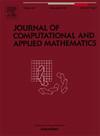Hemispheroidal parameterization and harmonic decomposition of simply connected open surfaces
IF 2.1
2区 数学
Q1 MATHEMATICS, APPLIED
Journal of Computational and Applied Mathematics
Pub Date : 2024-12-24
DOI:10.1016/j.cam.2024.116455
引用次数: 0
Abstract
Spectral analysis of open surfaces is gaining momentum for studying surface morphology in engineering, computer graphics, and medical domains. This analysis is enabled using proper parameterization approaches on the target analysis domain. In this paper, we propose the usage of customizable parameterization coordinates that allow mapping open surfaces into oblate or prolate hemispheroidal surfaces. For this, we proposed the usage of Tutte, conformal, area-preserving, and balanced mappings for parameterizing any given simply connected open surface onto an optimal hemispheroid. The hemispheroidal harmonic bases were introduced to spectrally expand open parametric surfaces by generalizing the known hemispherical ones. This approach uses the depth of the hemispheroid as a degree of freedom to control the size of the parameterization domain of the open surfaces while providing numerically stable basis functions. Several open surfaces have been tested using different mapping combinations. We also propose optimization-based mappings to serve various applications on the reconstruction problem. Altogether, our work provides an effective way to represent and analyze simply connected open surfaces.
求助全文
约1分钟内获得全文
求助全文
来源期刊
CiteScore
5.40
自引率
4.20%
发文量
437
审稿时长
3.0 months
期刊介绍:
The Journal of Computational and Applied Mathematics publishes original papers of high scientific value in all areas of computational and applied mathematics. The main interest of the Journal is in papers that describe and analyze new computational techniques for solving scientific or engineering problems. Also the improved analysis, including the effectiveness and applicability, of existing methods and algorithms is of importance. The computational efficiency (e.g. the convergence, stability, accuracy, ...) should be proved and illustrated by nontrivial numerical examples. Papers describing only variants of existing methods, without adding significant new computational properties are not of interest.
The audience consists of: applied mathematicians, numerical analysts, computational scientists and engineers.

 求助内容:
求助内容: 应助结果提醒方式:
应助结果提醒方式:


